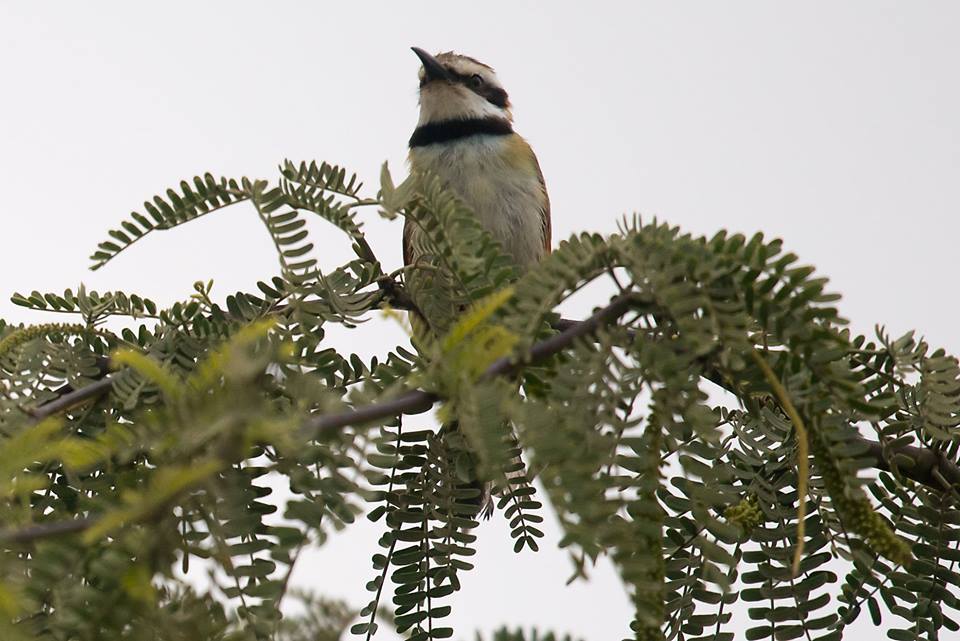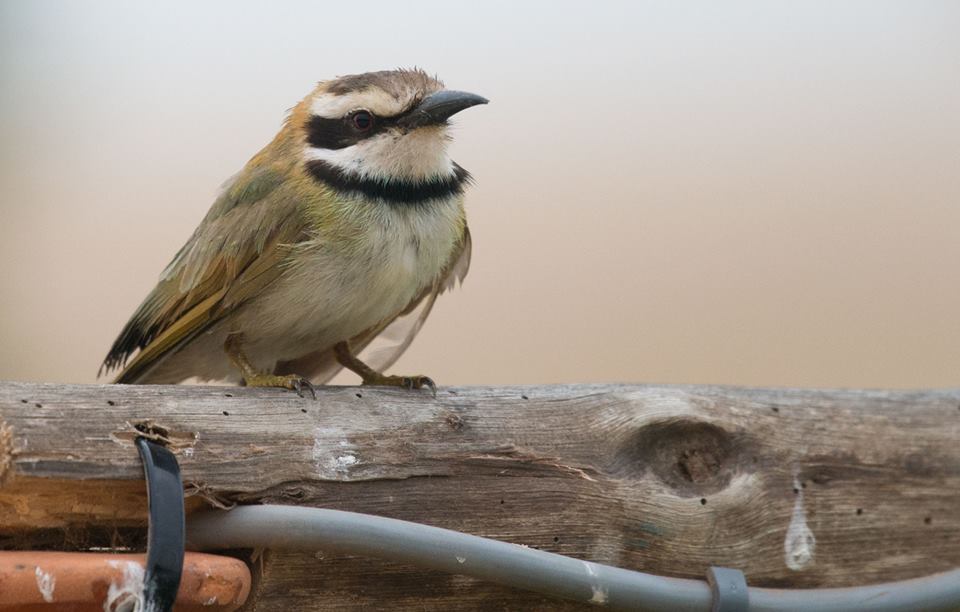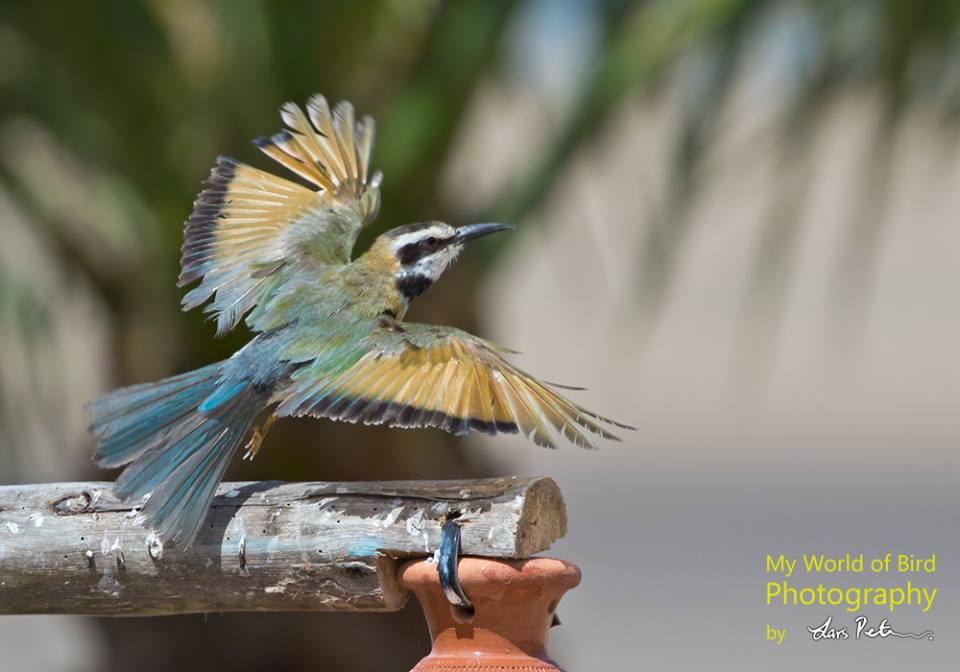White-throated Bee-eater at Dakhla Bay: second record for Morocco and the Western Palearctic.

The White-throated Bee-eater was found at Dakhla Bay, Oued Dahab region on 28 February 2017 by Billy Herman and Annelies Jacobs. It’s the second WP record for the species. It should be remembred that the first record was observed at the site known to birders as ‘Gleb Jdiane’ in December 2013 (correct name of that place is not Gleb Jdiane but Tachektent).
On 2 March, Arnoud van den Berg got got some photos (one above and one below) and commented the following:
On our way back from Morocco today, we were lucky to watch this tattered silent White-throated Bee-eater / Witkeelbijeneter (Merops albicollis). It was found two days ago (28/2) by Billy Herman and Annelies in the garden of their Attitude resort at Dakhla bay, Oued ed Dahab-Lagouira, Western Sahara. This place may be the only sizeable green patch in the vast desert area along this coast. The bird’s battered plumage suggests it must have had a hard time when flying north instead of south from its breeding range in southern Mauritania. If accepted, the bird constitutes (only) the second record for the Western Sahara and the WP; the first was at Gleb Jdiane in December 2013.

Based on the state of the bird’s feathers, some birders started suggesting possible captive origin of the bird. I highly doubt this. Crossing the Sahara desert is not an easy task especially when the bird is disorientated as happened in this case (totally agree with Arnoud). I have seen birds of the same size as this bee-eater in their normal migration over the Sahara in a very bad condition. I also doubt if there is anyone who keeps these birds as pets anyway.
Arnoud added this comment in facebook when asked about the possibility of the bird being an escape:
Indeed, the plumage damage could have been caused by someone who picked it up without knowing how to handle it properly. Quite possibly even at this surfers’ hotel this winter. It does not look like a bird from a cage though as the nails are fine and sharp.
Good birding!
Updates:
– The White-throated Bee-eater still at Dakhla Attitude hotel on 4 March (Dan Brown/BiOME Consulting). See one of his photos below and more in Twitter.

– The bird looks good as he was observed by several Western Palearctic birders feeding on insects. For example, in Phil Abbott’s photo taken on 10 March we can see the bee-eater feeding. On 16 March, Bodor Gábor filmed the bird actively feeding on insects (see the video at the bottom of this page).

– On 17th March, Lars Petersson took a photo of the bird showing the symmetric moult of flight feathers.

– The bird still at Dakhla Attitude hotel on 24 March, Max Berlijn saw the bird and commented this at observation.org: “Feeding in the wind. Quite worn individual. I saw it also sitting in the middle of an acacia; this, and his age, could explain its worn feathers”.
– The bird was still present on 11 April, flycatching successfully but still looking a bit tatty! (Andrew Whitehouse).
Sure, the bird feels like he own the place (note the same spot in photos 2, 4 and 5).
A nice short note about the species is published in Dutch Birding in 2018:
Jacobs, A. Herman, B. & Bertrands, J. 2018. White-throated Bee-eaters in Western Sahara, Morocco, in December 2013 and February-May 2017. Dutch Birding 40: 29-32
Très étonnant. Guêpier abondant en zone sahélienne pendant la mousson (juillet-septembre), arrivant des latitudes pré-guinéennes plus ou moins tôt en précédant les flux du Front Inter Tropical (FIT), très progressivement dès mars avec un pic d’arrivée en mai et juin et redescendant en octobre-début novembre. https://ornithondar.blogspot.com/2015/03/27-ranch-de-bango-un-guepier-gorge.html
Merci Frédéric pour le commentaire.
Si je comprends bien, cette observation est environ un mois plus précoce que l’observation la plus précoce obtenue au Sénégal à ce jour (qui est 27 mars comme indiqué dans ton blog).
Compte tenu de ton expérience dans le nord du Sénégal, que penses-tu de ces théories:
– Sur la base des premières photos, de nombreux observateurs sur Internet ont soupçonné une “possible origine captive”. Cette théorie, déjà faible, est réfutée par les observations d’Arnoud cité plus haut.
– Parce que les plumes sont effectivement endommagées, certains observateurs ont proposé cette théorie: “peut-être un chauffeur a attrapé l’oiseau plus au sud (en Mauritanie?), puis l’a transporté vers le nord dans l’espoir d’une vente, puis libéré ou échappé à Dakhla?”
– L’oiseau est arrivé à Dakhla très tôt (il y a des mois)?
– L’oiseau vient d’arriver à Dakhla à la fin de février (il a perdu son chemin lors de leur migration très précoce vers le nord)?
Nous devrions également tenir en compte l’observation précédente en décembre 2013.
https://magornitho.org/2013/12/merops-albicollis-new-species/